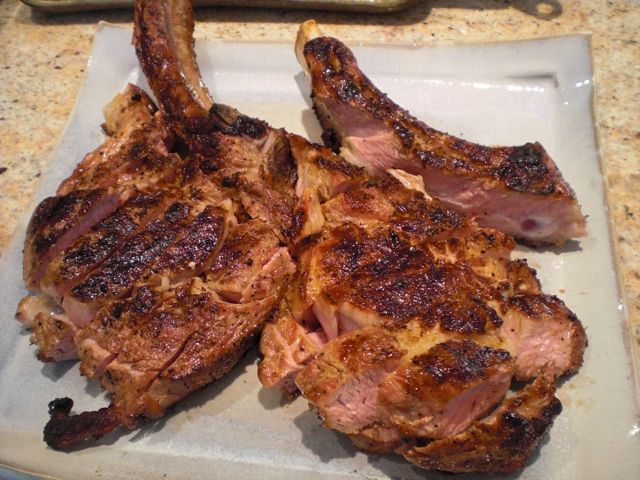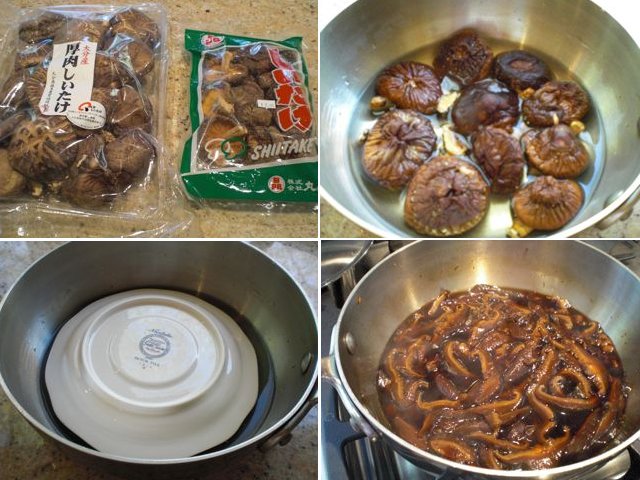I thought this was a rather nice dish. The sauce is nicely earthy with a Japanese touch. Veal chop are not usual cuts of meat I use. I was told that I could blog this after the publication of the cookbook. The book was published sometime ago and I bought a copy myself. Since I am running short of something to post I decide to post this dish.

 I am trying to remember what this tasted like. When I tasted the sauce by itself, I thought it was too salty and strong. But once it was poured over the cooked veal chops, it was just right amount of saltiness. The sauce added a very nice "umami"-laden mushroom flavor. When I did this, I invited 2 couples (non-Japanese) and asked them to taste and give us feedback. I think this was very well received.
I am trying to remember what this tasted like. When I tasted the sauce by itself, I thought it was too salty and strong. But once it was poured over the cooked veal chops, it was just right amount of saltiness. The sauce added a very nice "umami"-laden mushroom flavor. When I did this, I invited 2 couples (non-Japanese) and asked them to taste and give us feedback. I think this was very well received.
This is the instruction I received. I did not compare the final recipe with this one.
Serves 4
For the shiitake dashi:
12 whole dried shiitake mushrooms, about 1/2 ounce
1 cup water
1/2 cup sake
1/2 cup soy sauce
2 tablespoons mirin
1 tablespoon corn starch
1 tablespoon water
4 veal chops, about 4 pounds
Salt
Freshly ground pepper
To make the shiitake dashi: Add the shiitake and water to a saucepan and let it soak for 4 hours at room temperature. Transfer the shiitake to a cutting board, without discarding the water in the saucepan, and thinly slice the mushrooms. Return the mushrooms to the liquid in the saucepan. Add the sake, soy sauce and mirin to the saucepan, and bring it to a boil over medium heat. Lower the heat so the liquid simmers, and cook for about 15 minutes, until the liquid reduces by 1/3. Skim off any scum that appears on the surface. While the dashi simmers, mix together the corn starch and water in a small bowl, and set aside. When the dashi has reduced, remove the saucepan from the heat. Add the corn starch mixture, and stir until the dashi thickens. Let the dashi come to room temperature.
Use a meat pounder or mallet, or the side of a heavy knife or cleaver, to pound the veal chop 6 times, to flatten and condense the meat. (Be careful not to strike the bone.) Season with salt and black pepper on all sides of the chops. Slap the sides of the veal with your palm, so the pepper sticks to the meat.
Preheat a grill to medium-hot heat. Grill the chops for about 5 minutes on each side for medium rare. When the chops are done, the bone will stick out, as the meat along it shrinks, and the veal will become richly caramel colored. Test for doneness using the nick and peek method. Let the chops rest for about 3 minutes. Drizzle 2 tablespoons of shiitake dashi over the veal chops, and serve.
Other uses for shiitake dashi: Drizzle over steaks and burgers. The dashi can keep in the refrigerator for 3 weeks, and also freezes well.
The picture below is just showing the dried mushroom on the left upper image. The quality of dried mushroom could be quite different from brand to brand. I rehydrated the dried mushroom by placing the small plate so that the mushrooms are completely submerged. The right lower image is the final Shiitake dashi sauce. I did not take the picture of pork chops with this sauce on it.






